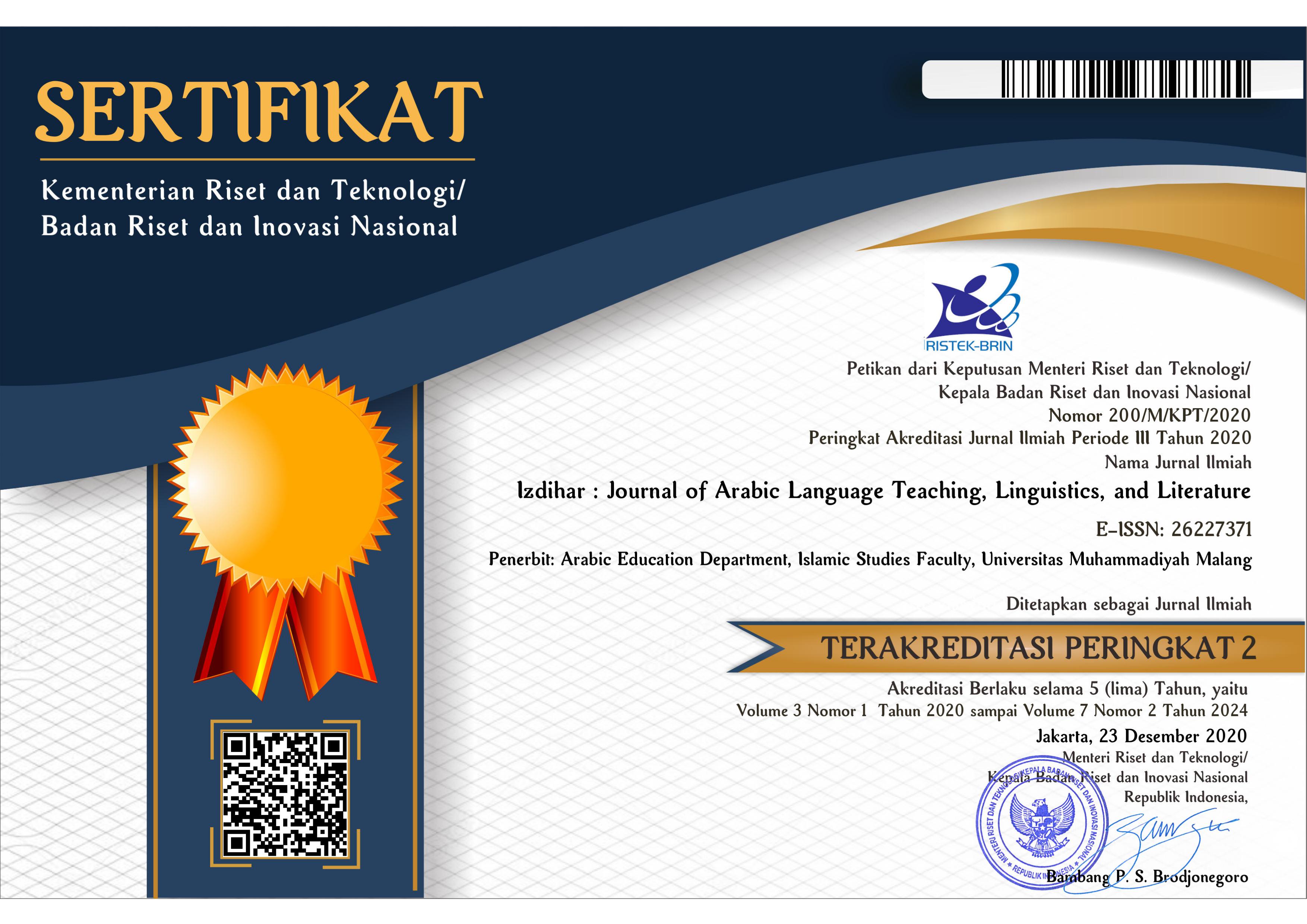Contrastive Analysis of Kinship Terms between Arabic and Indonesian Languages: Anthropolinguistic Study
DOI:
https://doi.org/10.22219/jiz.v5i1.18860Keywords:
Arabic Language, Contrastive Analysis;, Kinship TermsAbstract
Greeting words are the most widely used words in daily communication. Many greetings are taken from the kinship term. Each language has different kinship terms based on its culture. This study aims to describe (1) the Arabic kinship term, (2) the Indonesian kinship term, and (3) the similarities and differences between the Arabic and Indonesian kinship terms. This research is a qualitative research with contrastive and anthropolinguistic analysis approaches. The data of this research are the vocabulary of kinship terms in Arabic and Indonesian which are taken from various sources. The results are (1) Arabic kinship terms are more varied than Indonesian, (2) Arabic kinship terms have syntactic markers to distinguish between terms for male and female, (3) based on the patrilineal system applies to the Arab community, Arabic distinguishes between terms for father's line and mother's line, (4) in Indonesian, there are terms that are differentiated by age, (5) in terms of nature, the kinship term in Arabic is descriptive, while in Indonesian is descriptive and classified, (6) the terms of kinship in Arabic and Indonesian can be addressed to non-relatives so that both can be metaphorical.
Downloads
References
Ainin, M. (2010). Metodologi penelitian bahasa Arab. Malang.
Al Fuadi, M. (2014). Family structure and kinship terms in the Arabic tradition. (ISBN978-5-209-06290-5), 189–200.
Al-Ghalayaini, M. (1994). Jami'ud Durus al-Arabiyyah. Darul Fikr.
Al-Ghazalli, M. F. (2018). Lexical gaps in Arabic-to¬-English translation. Mustansiriyah Journal of Arts (MuJA), 34(52), 1-16. https://www.iasj.net/iasj/article/36025
Al-Sahlany, Q. A., & Al-Husseini, H. A. (2010). Kinship terms in English and Arabic: A contrastive study. Majallah Universitas Babilonia, 18(3). 709-726
Aqil, A. I. (1980). Syarah Alfiyyah ibn Malik. Daru Mishra lit Tiba'ah.
Barakat, H. (2012). Dunia Arab: Masyarakat, budaya dan negara. Nusa Media.
Baransano, A. (2014). Istilah kekerabatan dalam bahasa Inggris dan bahasa Kayupulo (suatu analisis kontrastif). Jurnal Elektronik Fakultas Sastra Universitas Sam Ratulangi, 3(1). 1-17. https://ejournal.unsrat.ac.id/index.php/jefs/article/view/5746
Basilius, H. (2014). Neo-humboldtian ethnolinguistics. Word, 8(2), 95–105. DOI: https://doi.org/10.1080/00437956.1952.11659424
Burling, R. (1970). Man’s many voices: Language and it’s culture. Holt, Rinehart and Winston Inc.
Chaer, A. (2006) Tata bahasa praktis bahasa Indonesia. PT Rineka Cipta.
Dirani, J., & Dietrich, A. (2018). Analysis of letter representation using Latin and Arabic scripts: A masked priming study. Journal of psycholinguistic research, 47(5), 1151-1161. https://doi.org/10.1007/s10936-018-9584-5
Duranti, A. (2003). Linguistic anthropology. Cambridge: (1st ed.). Cambridge University Press.
Khalifa, M. F. (2018). Contrastive analysis, error analysis, markedness theory, universal grammar and monitor theory and their contributions to second language learning. International Journal of Linguistics, 10(1), 12–45. https://doi.org/10.5296/ijl.v10i1.12479
Lyons, J. (1995). Pengantar teori linguistik terjemahan I. Soetikno. Gramedia Pustaka Utama.
Lado, R. (1971). Linguistic across culture. The University of Michigan Press.
Leech, G. (1974). Semantics: The study of meaning, Second Edition. Richard Clay.Ltd.
Muhammadun, M. (2016). Penanda gender dalam perspektif bahasa Arab dan bahasa Indonesia (sebuah analisis kontrastif). AL-MAIYYAH: Media Transformasi Gender dalam Paradigma Sosial Keagamaan, 9(1), 46-86. https://ejurnal.iainpare.ac.id/index.php/almaiyah/article/view/334
Nasution, S., Fithriani, R., Syahnan, M., Harahap, I., & Qarni, W. (2019). A contrastive analysis of Indonesian and Arabic phonetics. KnE Social Sciences, 722–732. https://doi.org/10.18502/kss.v3i19.4899
Neelakshi, S., & Amr, K. (2021). Kinship terms as indicators of identity and social reality: A case study of Syrian Arabic and Hindi. Russian Journal of Linguistics, 25(1), 125-146. https://doi.org/10.22363/2687-0088-2021-25-1-125-146
Nikmah, K. (2019). Interrogative sentence: A contrastive study of Arabic and Indonesian. Izdihar: Journal of Arabic Language Teaching, Linguistics, and Literature, 2(3), 183-200. https://doi.org/10.22219/jiz.v2i3.10148
Nur, T. (2016). Analisis kontrastif dalam studi bahasa. Arabi: Journal of Arabic Studies, 1(2), 64-74. https://doi.org/10.24865/ajas.v1i2.11
Nunan, D. (1999). Second language teaching & learning. Heinle & Heinle Publishers, 7625 Empire Dr., Florence, KY 41042-2978. ERIC Number: ED441344
Pribadi, M. (2013). Kasus analisis kontrastif bahasa Indonesia dan bahasa Arab serta implikasinya dalam pengajaran bahasa (analisis deskriptif metodologis). Adabiyyāt: Jurnal Bahasa dan Sastra, 12(1), 157-189. https://doi.org/10.14421/ajbs.2013.12108
Reiter, R. M. (2000). Linguistic politeness in Britain and Uruguay: A contrastive study of requests and apologies (Vol. 83). John Benjamins Publishing.
Richards, J. C. (2001). The role of textbooks in a language program. Cambridge University Press.
Rodero, E. (2015). The principle of distinctive and contrastive coherence of prosody in radio news: An analysis of perception and recognition. Journal of Nonverbal Behavior, 39(1), 79-92. https://doi.org/10.1007/s10919-014-0201-5
Rohayati, E. (2018). Analisis kontrastif dalam pembelajaran bahasa Arab. Taqdir, 4(2), 105-117. https://doi.org/10.19109/taqdir.v4i2.3126
Ulfayanti, N., & Jelimun, M. O. (2018). Contrastive analysis of English and Indonesian vowel phoneme and its lesson plan in language teaching. Journal of Applied Studies in Language, 2(2), 116-123. https://ojs.pnb.ac.id/index.php/JASL/article/view/1030
Wardhaugh, R. (2006). An Introduction to sociolinguistics. Malden USA Blackwell Publishing.
Yahya, L. (2021). Code mixing and interference in the Arabic conversation of non-arabic speakers/اختلاط الرموز والتداخل اللغوي في الاتصال باللغة العربية للناطقين بغيرها. Al-Arabi: Journal of Teaching Arabic as a Foreign Language, 5(1). 65-80. http://dx.doi.org/10.17977/um056v5i1p%25p
Downloads
Published
How to Cite
Issue
Section
License
Copyright (c) 2022 Kholisin Kholisin, Rohma Maulidya, Muhammad Alfan, Moh. Fery Fauzi

This work is licensed under a Creative Commons Attribution-ShareAlike 4.0 International License.
Copyright Notice
Authors who publish with this journal agree to the following terms:
- Authors retain copyright and grant the journal right of first publication with the work simultaneously licensed under a Creative Commons Attribution-ShareAlike 4.0 International License that allows others to share the work with an acknowledgment of the work's authorship and initial publication in this journal.
- Authors are able to enter into separate, additional contractual arrangements for the non-exclusive distribution of the journal's published version of the work (e.g., post it to an institutional repository or publish it in a book), with an acknowledgment of its initial publication in this journal.
- Authors are permitted and encouraged to post their work online (e.g., in institutional repositories or on their website) prior to and during the submission process, as it can lead to productive exchanges, as well as earlier and greater citation of published work (See The Effect of Open Access).
Copyright (c) 2019 Izdihar : Journal of Arabic Language Teaching, Linguistics, and Literature

This work is licensed under a Creative Commons Attribution-ShareAlike 4.0 International License.


















